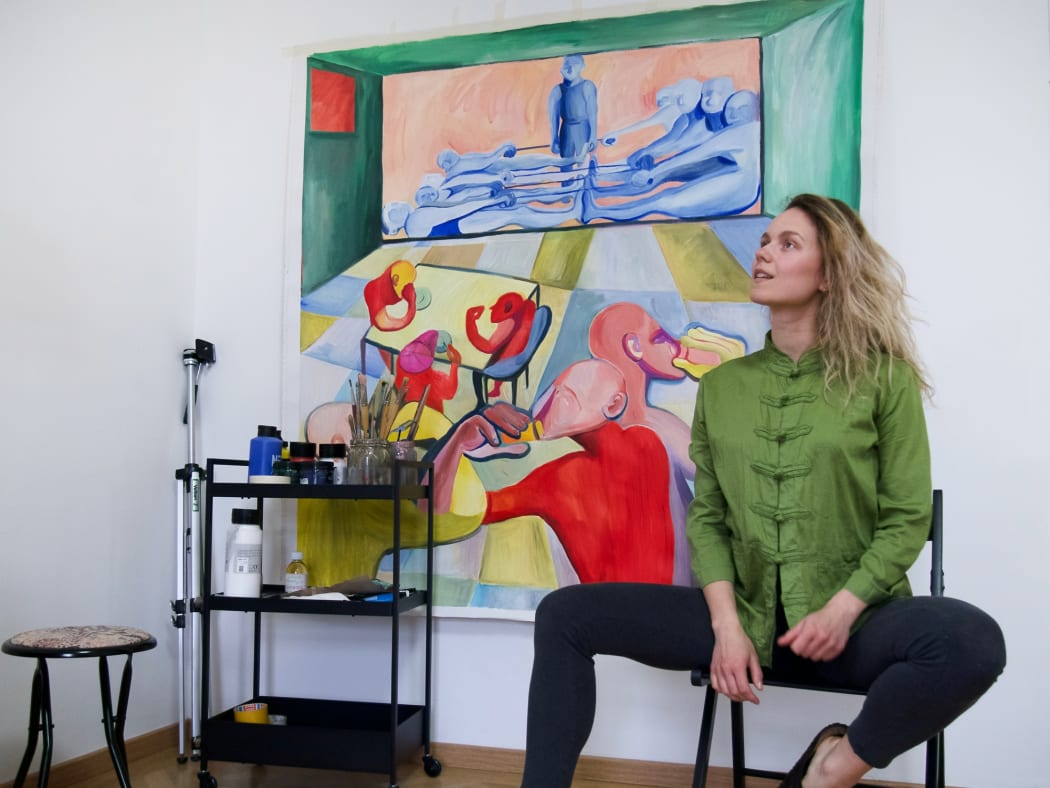
Let's escape from the world of daily tasks and administration: How does your usual work day start like? How do you usually start into your day once you're focused?
My ideal day is when I wake up very early. The best time to work is very early in the mornings because I feel that the brain is not yet spoiled with any unnecessary information. What I aim to do is to neither research nor read but just to produce in those golden hours.
Referring from these calm ‘tranquille’ periods of the day, when looking into your paintings and Psychotherapist series, how did the series develop? Has Vienna a certain standing from its historical perspective of Sigmund Freud and other thinkers; has it influenced you in a particular way?
Vienna has influenced me for sure, as any other city would. Maybe it's not a random chance that the particular series occurred while I'm living here. It is connected to my personal experiences while I've been in search of a psychotherapist. At the time I was intensively integrated into the community of psychotherapists here, as many friends were involved in the field. During many months, every appointed therapist turned out to be a friend of a friend or acquaintance of someone which is, by the rules, prohibited. It was my kind of illusion to find the therapist that doesn't exist because he/she has to absorb all your roles, which you and I wish him/her to be. I knew that this somebody has to be a woman, that she has to be also a feminist in a way, that she has to have the specific body that you feel warm and welcome sitting right next to it. It is like the theory of Jacques Lacan, where this wish becomes an "object a", the unattainable object of desire, this void which is a non-existent projection. Due to the urge to project my ideas on the perfect psychotherapist, I decided to implement it in my paintings because I knew: once I'll find the therapist, this series will be over, that's for sure. And this is how it happened.
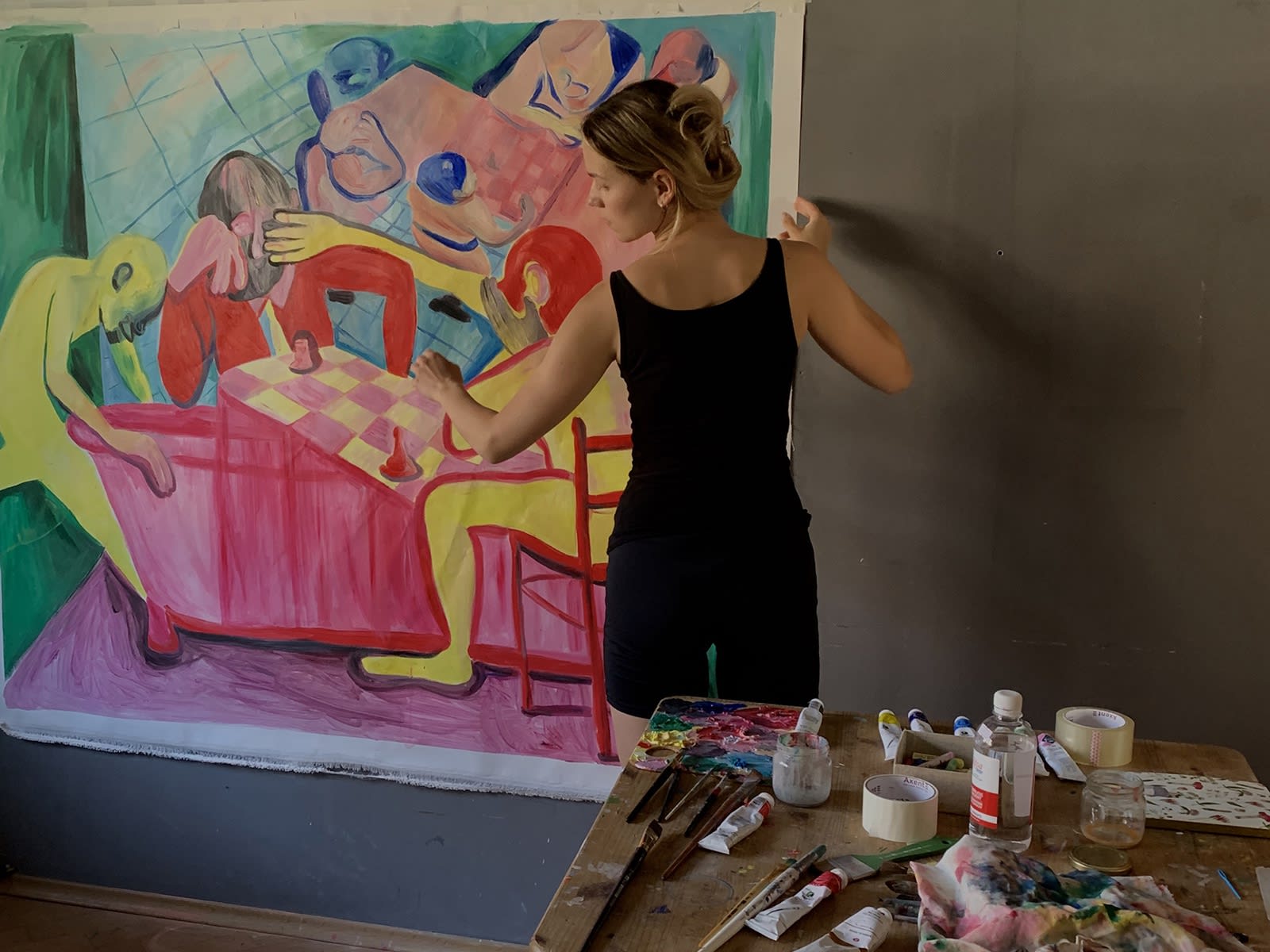
© Alina Sokolova Studio
I remember when studying at the Academy of Fine arts, there were Psychologists free of service which was important personally due to post-traumatic events when considering living in a very violent country like South Africa for many years. When I finished studying, there were even more Psychologists implemented in the institution because the demand of Students, Teachers, Professors was so high. How was art school for you? Do you think the Academy of Fine Arts influenced you in any particular way?
The most important and fascinating thing at the Academy, was the process of allowing myself to become a painter. This very gradual, very slow process of simply saying to myself, with every new work you allow yourself to become a painter; one step further. I started in the figurative painting class but moved away from that practice for a while and switched class. My odyssey back to painting was facilitated by a temporary move to other media that allowed me to develop artistically and intellectually. Bringing the knowledge I acquired through this experimental phase, I have managed to understand what was missing from my paintings earlier.
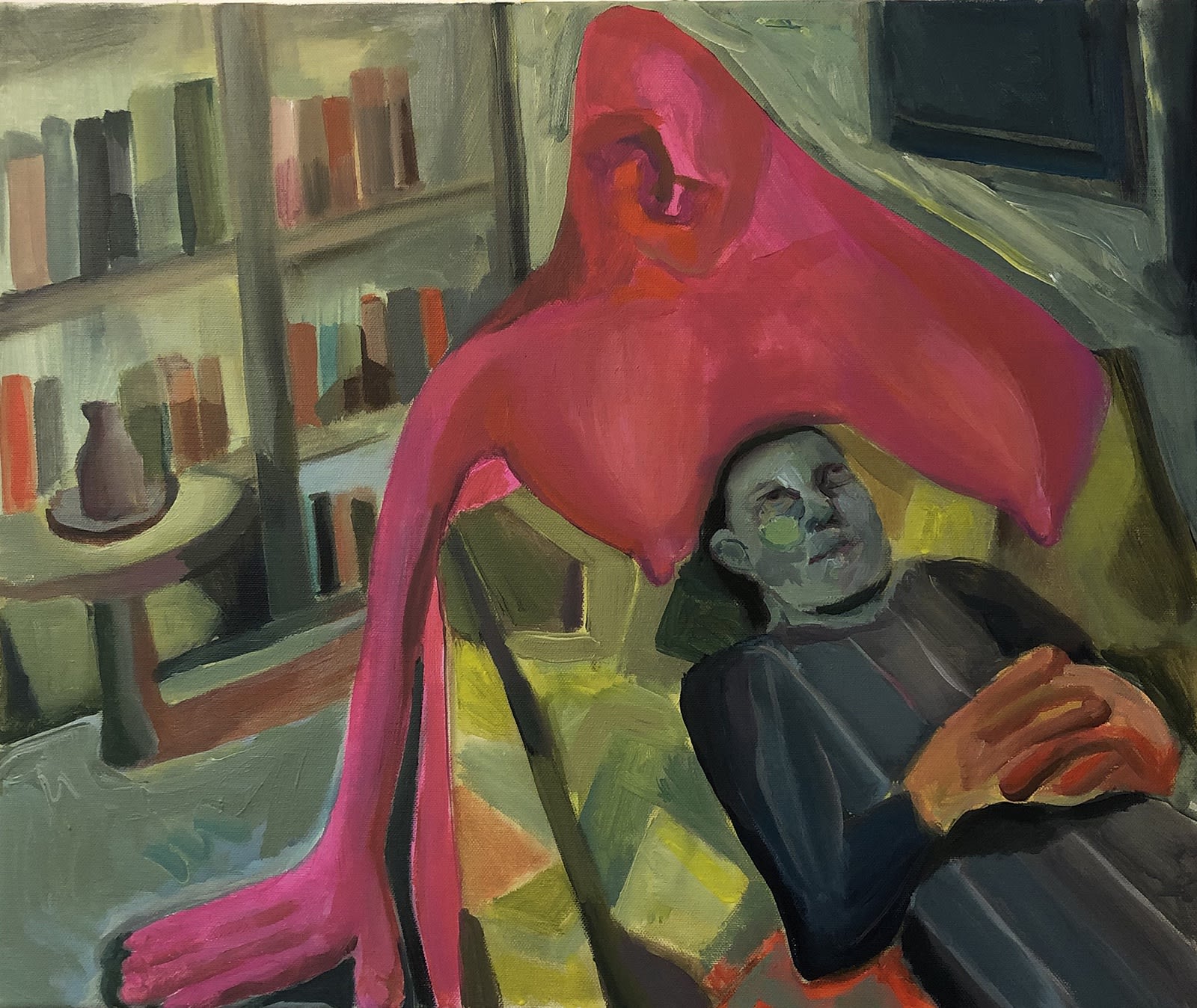
Alina Sokolova, Dreams of a desirable yet inaccessible therapist as a petit objet a, 2020, Oil on canvas, 60 × 50 cm 23.6 × 19.6 in
Is there something particular which has influenced you?
The way we had weekly art shows in our class which we presented in public. The discussions, to see how my colleagues work, what they read, and how they curate their own little space influenced me a lot. Also, having conversations with Professors and their team about various artists and books you can look up and possibly relate to. Those are experiences you simply do not get when working alone.
Art classes are a lot about reflection, and reflecting each other: How do you reflect on your own artistic practice? How does this process start?
‘The movements of the workers’ series or ‘The Choreography of Labour’ series was different in the approach from the psychotherapy paintings because it was not impulsive but rather divided in time, and a layered thinking process. My artistic practice in general can be described as an elaborate exploration of movement. I have a special interest in the repetitive gestures of contemporary labor, and the mechanization of our everyday life. I am fascinated by the exploration of movements that have become common property and are a testament to their time, and the ever-changing social climate. My interest in dance practices developed and evolved gradually over several years.
It started in 2018, when I was fascinated to observe and study the movements of river smugglers in the landscape. They crossed the riverbed near my hometown, who exquisitely performed the act of smuggling while being in the water flow. Trying to capture the patterns of their choreography, led me directly to large format painting, as the sheer size of the canvas gave me the chance to mirror the movements of the smugglers whilst painting.
It led me to questions like: how does contemporary labor looks like when we see it visually? Therefore I invited participants who were willing to lend me the movements of their labor. When typing on a laptop for hours as a side job, or bartenders who certainly know where a glass is standing on their left side; all these automatic movements become inherently incorporated in our muscular apparatus. We constructed a choreography that evolved into large-scale paintings.
It led me to my graduation project: How masses of people interact on the streets, during demonstrations or protests; or how people collide with each other but are not aware of it. I did a lot of research on how people react in masses to specific events in history – this was more of a historical research; It always starts with a fascination of a phenomena and/or what is happening around it.
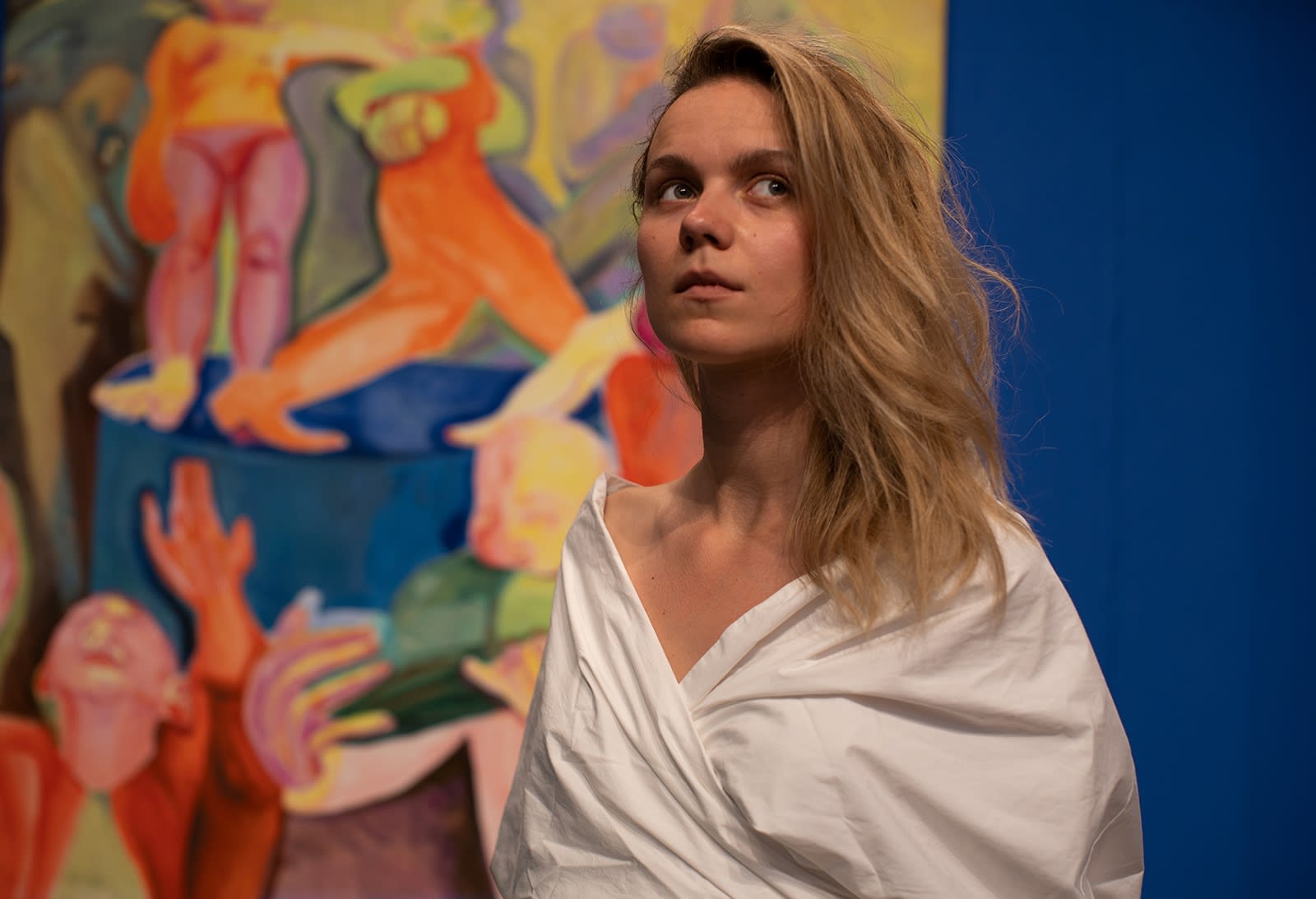
© Alina Sokolova studio. Image: Nika Rushchak
Your work has evolved from performative practices into painting. Is performance a particular element in your work?
I would say my work involves rather dance practices, and choreography. I have a strong interest and fascination in constructing choreographies myself. There is a need for me to expand painting beyond the painterly medium. That is why I like to combine both, to screen a choreography with video onto the canvas. I am fascinated by Yvonne Rainer, Pina Bausch, and the Bauhaus Dance Theatre. I think that dance is more relevant than the performance itself.
“Dancing is the loftiest, the most moving, the most beautiful of the arts, because it is no mere translation or abstraction from life; it is life itself” – Havelock Ellis, the Philosopher Maurice Merleau-Ponty, and Jean-Luc Nancy wrote essays; there are lots of quotes and texts on the body, on dance.
Exactly. In my project, I was interested in researching masses of people, how they lose control, experience mass spontaneity, or are moving under one single curated guidance. Body reaction or this mass dance reaction, is something very fascinating to me. It is one of the first art forms, one of the first forms of collaboration, and forms of togetherness.
Did you use any actual event as a reference of those gatherings?
There are three timelines. The first event takes place in 1518 in Strasbourg; it is the dancing plague of 1518 which was a middle-age phenomenon: in fact, people danced until they died. During this mass hysteria, people would “infect” each other with dancing and die of exhaustion. The next timeline was an exploration of leisure in the Soviet Union in 1920, it's about the formations of human pyramids. These often shaky and dilettante formations, a massive common body, were praising the culture of collectivism and patriotism, subconsciously. The third event was on TikTok, which I observed during the pandemic. My interest was based on the dance videos teenagers have created during the pandemic.
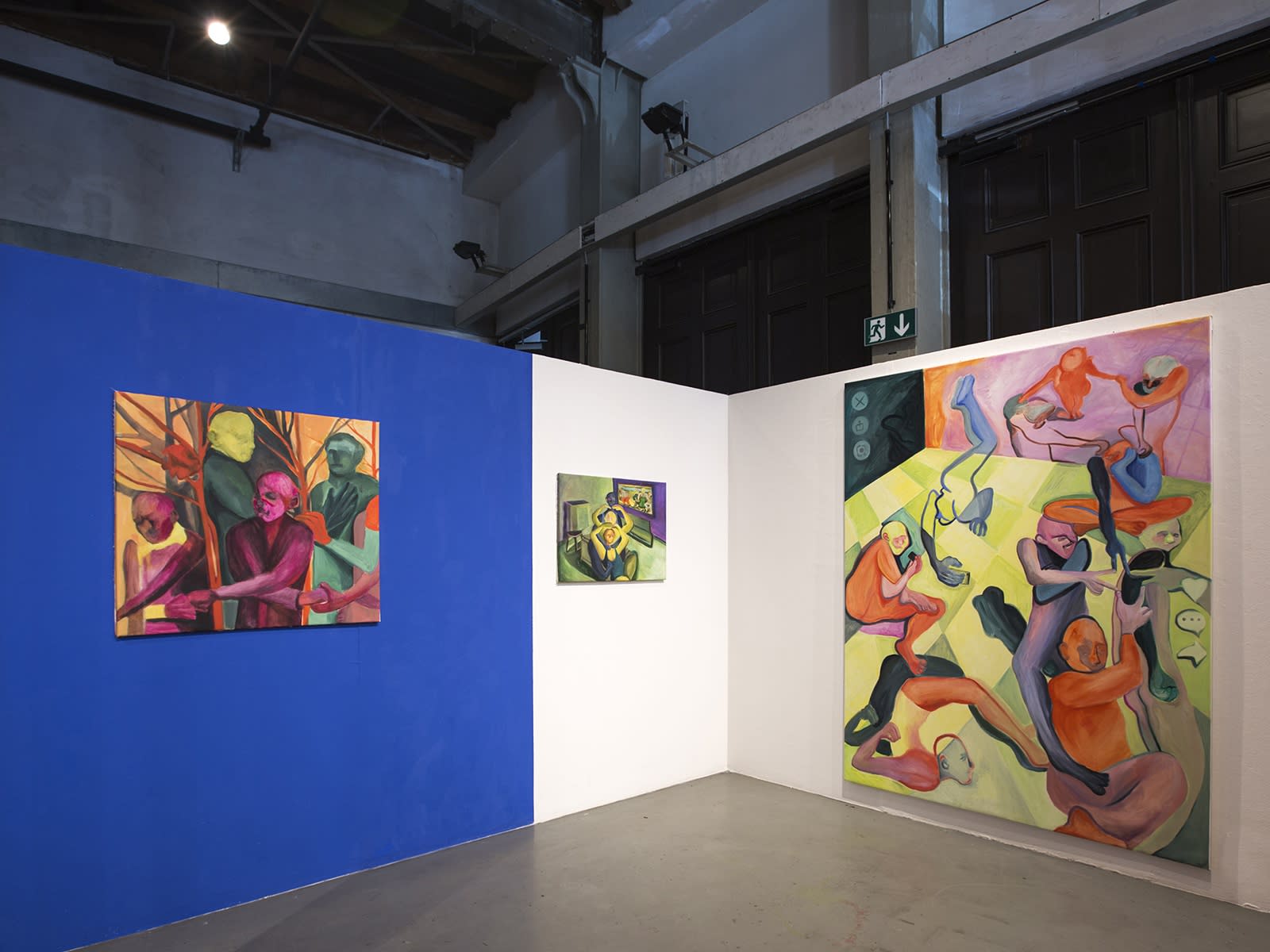
Alina Sokolova, The Dancing Plague, 2021, Installation view, Vienna
It reminds me of a dance in South Africa which is called Toyi-Toyi. People marched while dancing through the streets. It was performed in Apartheid, when people were segregated, they used the dance as their resistance against repression. When there is nothing left, all you have left is your body. You see it with Capoeira, the dance of liberty and freedom. Let’s speak about your paintings which interact with movement, and happen to be on social media: you made use of the new media in your paintings. What do you think about the next generation, expressing their needs, filtering their faces, how is communication changing for example?
Talking about the painting "When you forget to switch off your camera in zoom", it was born out of complete zoom boredom. It was very frustrating for me to sit in front of Zoom meetings, so I started sketching facial expressions of people in countless squares in front of me. I am not a person who enjoys the transition into complete digital communication. When I talk to people or my friends via Zoom, it is very different. I noticed I am less concentrated. The winter of 2020 was a point of complete escapism and I simply gave up in the participation of digital meetings.
TikTok was a fascinating platform for visual exploration because I looked at it as a stranger. After the event of the dancing plague, five hundred years later, people were reacting to an unknown crisis in the same way, with an urge to move. The only thing that changed, they did not go to the streets but they did go to a digital platform which was TikTok. For teenagers, at that very moment, it served as a kind of stress managing platform where they were able let out stress of being locked in at home. As an outsider, I am collecting their facial expressions, how they move, I try to understand by reconstructing them, using video choreographies and in paintings.

Alina Sokolova, When you forget to turn off your camera on zoom, 2020, Acrylic on canvas, 81 × 79 cm 31.8 × 31.1 in
Do you think TikTok takes off the pressure, or does it create another pressure?
Of course it also creates pressure: to compete, and to be visible. But I think during the pandemic it was also used as a platform to relieve stress.
Makes sense. Once someone starts creating, people are able to let out things; they can express, people are not as aggressive, or have as much of evil manners or intentions, while being productive, and while creating. With regards to your painting practice, is there an artist who influenced you in your work?
When I first came to Vienna, I was mesmerized by the permanent exhibition of Hieronymus Bosch at the Gemäldegalerie in the Museum of the Academy of Fine Arts Vienna. Peter Bruegel and Bosch are the two painters whom I would love to ask about those little details in the corner of their paintings. Pieter Bruegel was so courageous and good at painting; depicting his motifs of peasants in times, when everybody was doing something else.
Is there anything particular in color, in form, of which you are drawn to? Your paintings derive from this very vivid color palette, is there something particular about your selection of colors?
It has to do with the process itself: I simply enjoy the pureness in painting. At some point, I started to forbid myself to use particular colours, so for example, I stopped using black and white. The primary colors gave me a fresh perspective and another direction to add another dimension.

Alina Sokolova, Venuses in the Egan pub, 2020, Oil on canvas, 100 × 100cm 39.3 × 39.3 in
You were born in Ukraine. Is there any particular, maybe a Non-Western experience of how you grew up?
A lot of my works have a connection to the particular place where I grew up. I grew up in a town, which is a crossroad on the edge of three borders: Hungary, Slovakia and Romania. Experiencing the existence of borders almost daily, it later manifested itself into an interest in my practice. Seeing how the bureaucratic process works, entering from EU countries to Non-EU countries, seeing the houses on the hill, although you have to stand ten hours in the line, and you are not sure if you will get there.
I always wished to create choreographic pieces on the border. Once I did an artistic interaction on the border, I sent a huge message attached to air balloons. A sign which carried a message, flew to the other side of the border.
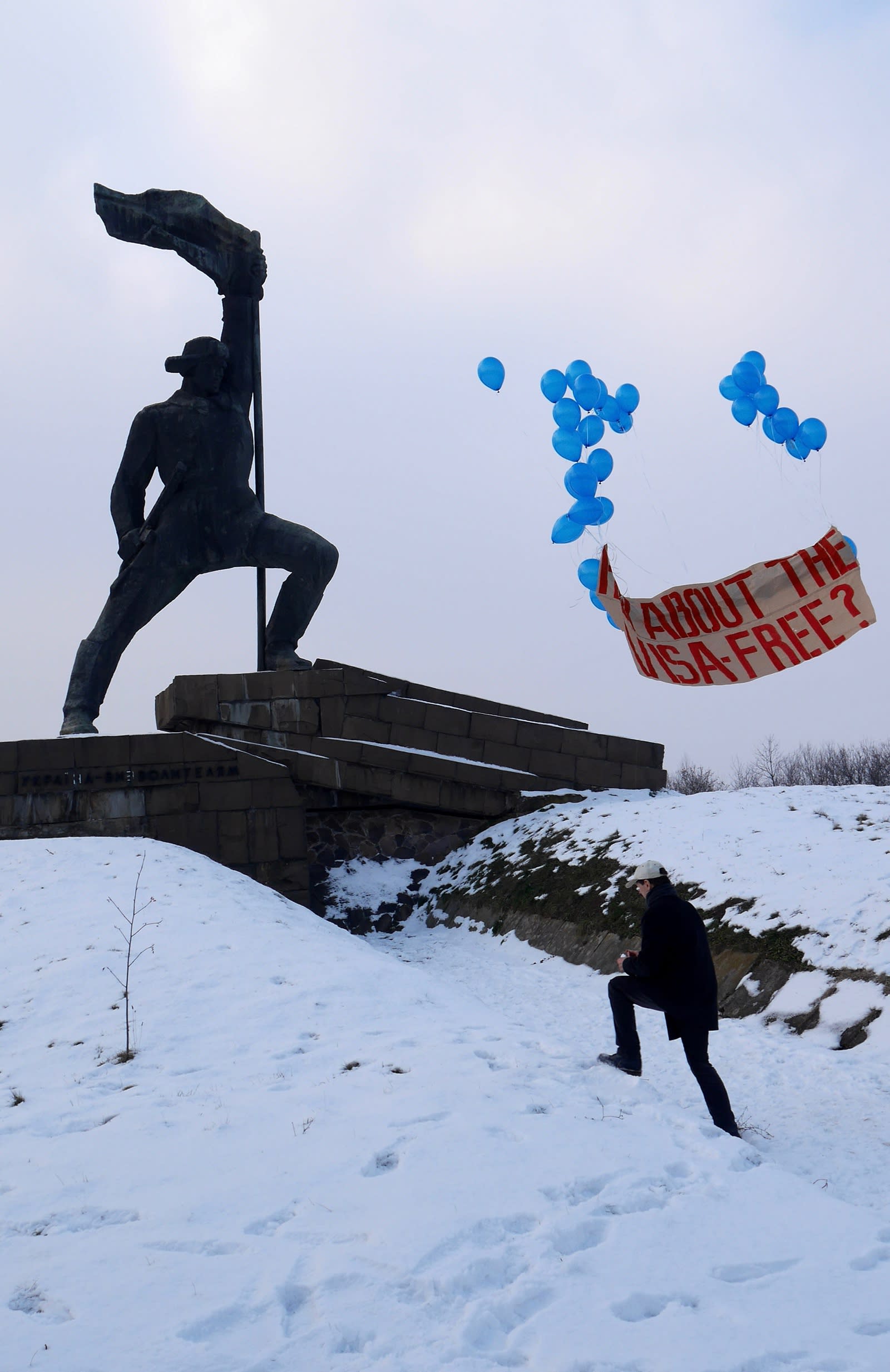
Alina Sokolova, How about the visa-free, 2017, Intervention
Did they catch you with a drone?
(laughing) Borders are imagined playgrounds for me. People who were waiting in line, were the spectators of this performance from all sides. Being a child, when the Soviet Union had already collapsed, being in-between the old and a new, I was still unexposed to any Western or American mass culture and cartoons. My non-existent knowledge of Western cartoons is still a topic of jokes among my friends. It was an interesting clash in culture, of course.
With regards to the human pyramid, can someone interpret any form of hierarchy or authority in this painting?
I do not like to imply a strict political agenda on a phenomenon. For me, a human pyramid entails everything. The gymnastics series were a great discovery, in comparison to any other dance phenomena and body formations. When looking at its collective pattern; it was neat, geometric and organized. Stumbling upon a massive archive of random photos in which people freely form gymnastic pyramids while having a picnic, during a house party, or at a factory, served as the starting point for my interest. They all seemed to volunteer of doing gymnastics, but we all know that this was not a voluntary act. Gymnastics, as such, and all mass sport formations were a definition of the "proper" free time spent and promoted as the "right leisure”.
How do use your body in your free time?
I need to move so that my brain activates. I go for walks, and I have a dog now. I go jogging, or I do any spontaneous dance.
Interview conducted by Katharina Balgavy